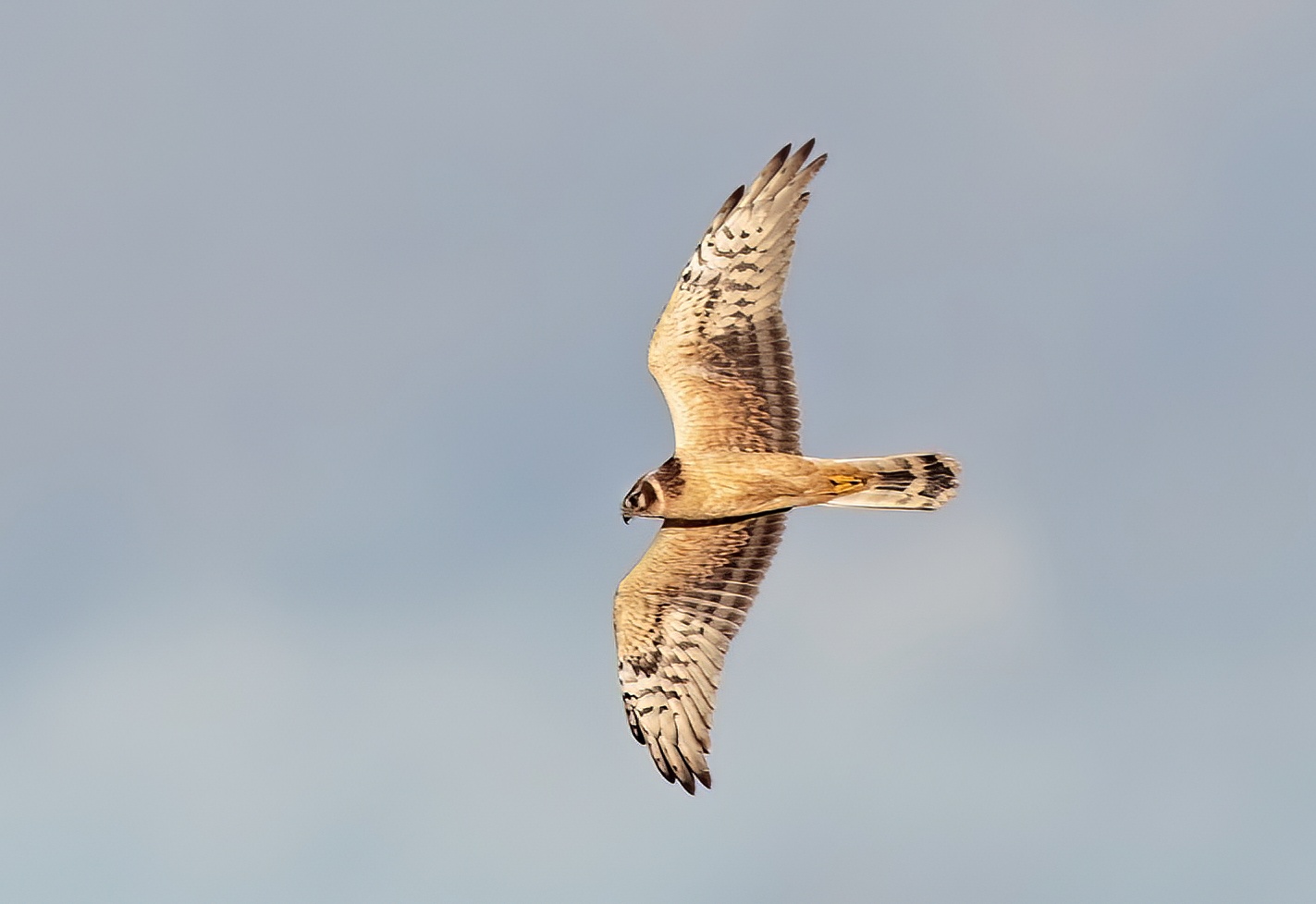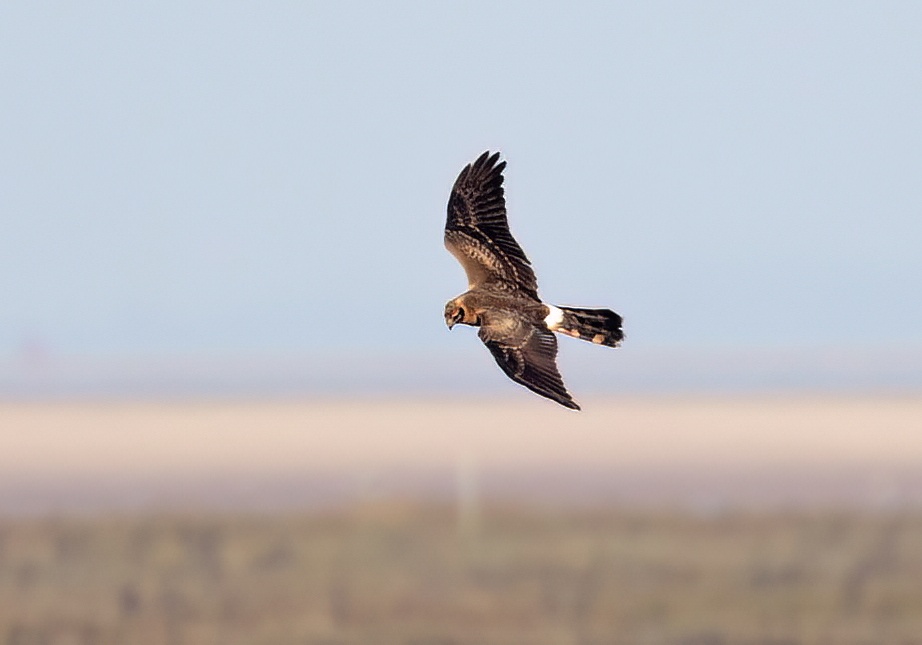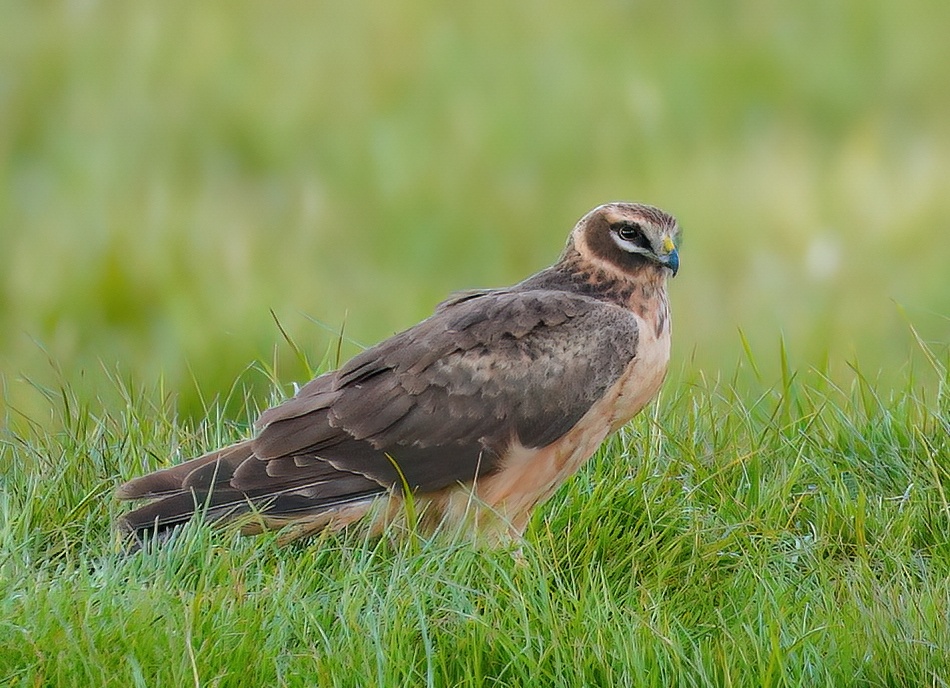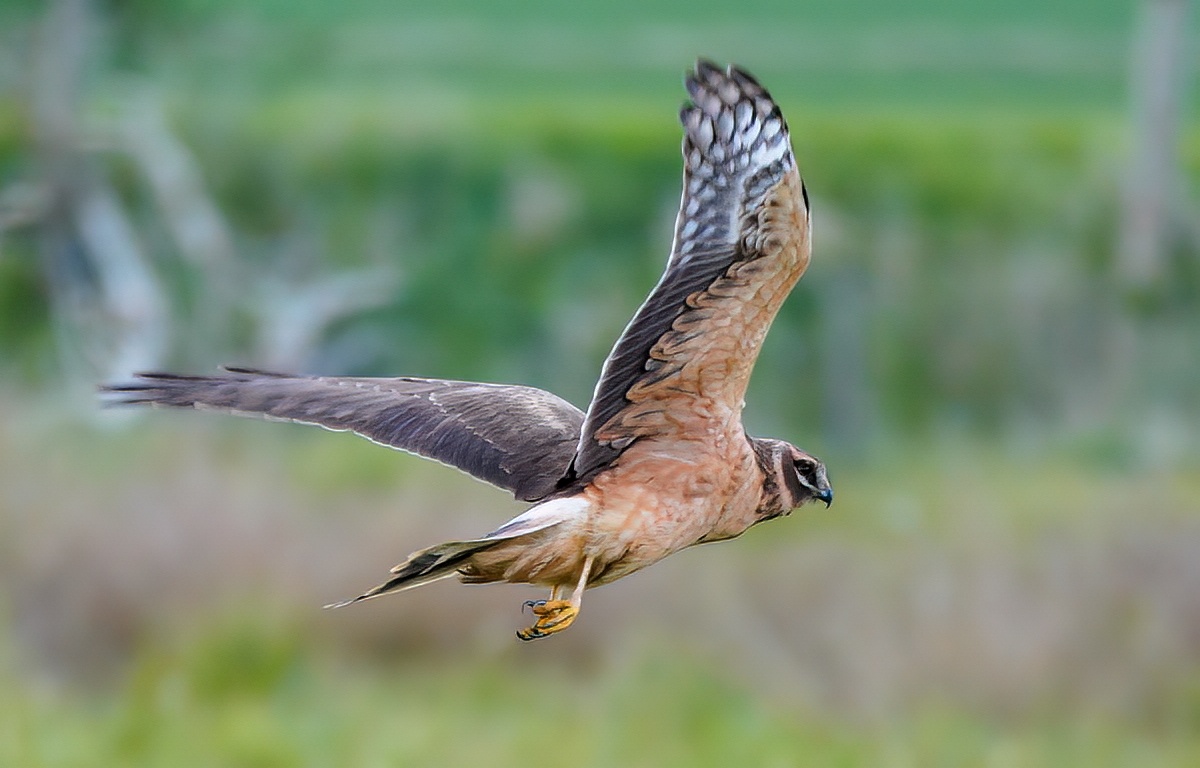Pallid Harrier Circus macrourus
Vagrant. Eastern Europe.

1CY Pallid Harrier at Gibraltar Point on November 7th 2015; photograph courtesy of Graham Catley.

1CY Pallid Harrier at Grainthorpe Haven November 10th 2016; photograph courtesy of Graham Catley.


2CY female Pallid Harrier at Bonby Carrs May 7th 2021; photograph courtesey of Lesley Everatt.
A 2CY bird at Gibraltar Point NNR in May 2012 was the first county record. The second wasn’t far behind, a 1CY bird at Donna Nook in October 2015 seen at Gibraltar Point NNR later in the month and into early November. It had been seen at Spurn before arriving at Donna Nook and after its departure it was seen in Norfolk November 15th-17th. Two birds were seen in 2016, the first a 2CY bird at Conisholme in May and the second another 1CY bird at Donna Nook in mid-November 2017. The 2021 record was a fly-through seen and well photographed by two lucky observers only.
The majority of Pallid Harriers winter in Africa south of the Sahara or in southern Asia, but a few remain in North Africa and the Middle East. Occasionally a few also overwinter in Europe including Britain: a juvenile was in Norfolk December 24th 2002-March 30th 2003, and another remained in Cornwall from December 4th 2009-January 25th 2010. Interestingly, a juvenile female that wintered in France, November 27th 2014-March 7th 2015 was identified from photographs as the same individual that had been at Steart, Somerset (600 km to the north), until November 7th 2014. It seems that Pallid Harriers are well able to survive in winter in the absence of locusts, their prime winter prey.
There were 27 Pallid Harriers in Britain in 2011 and 17 in 2017, averaging about four per year. BBRC noted the species’ transition from a seldom-encountered vagrant to one of the more regular national rarities. Since the discovery of regular breeding Pallid Harriers in Finland in 2011, they have spread westwards in Europe with a pair breeding in the Netherlands in 2017 and another in Spain in 2019. Two 3CY+ males had extended stays in Britain in 2017, and a breeding attempt in Britain in the near future is not without the bounds of possibility.
| Site | First date | Last date | Count | Notes |
| Gibraltar Point NNR | 08/05/2012 | - | 1 | 2CY. |
| Donna Nook | 27/10/2015 | 28/10/2015 | 1 | 2CY. |
| Gibraltar Point NNR | 29/10/2015 | 08/11/2015 | 1 | 2CY, presumed same as Donna Nook bird, also seen in Norfolk and Yorkshire. |
| Conisholme | 05/05/2016 | - | 1 | 2CY. |
| Tetney/Grainthorpe/DonnaNook | 08/11/2016 | 17/11/2016 | 1 | 1CY, also seen in Yorkshire. |
| Bonby Carr | 07/05/2021 | - | 1 | 2CY female. |
| Gibraltar Point NNR | 01/05/2023 | - | 1 | 2CY male. |
| Anderby Creek | 06/05/2023 | - | 1 | 2CY male, presumed same as that of 01/05/2023. |
| Saltfleetby-Theddlethorpe Dunes NNR | 08/05/2023 | - | 1 | 2CY male, presumed same as that of 01/05/2023. |
| Gibraltar Point NNR | 10/05/2023 | - | 1 | 2CY+ male, assumed different from that of 01/05/2023. |
| Winterton Carrs, Ancholme Valley | 26/01/2024 | 27/01/2024 | 1 | 2CY, presumed female. |
Finder’s report: Pallid Harrier at Gibraltar Point NNR, May 8th, 2012, first county record
by K. M. Wilson
Note: this account is taken from the original BBRC submission. There were four British records in 2012 in all, 61 since 1950 although the astonishing influx in 2011 added 29 of these records (notwithstanding the difficulties of trying to assess how many individuals this involved).
Circumstances
With the unprecedented autumn invasion of juvenile Pallid Harriers into Britain in 2011, it seemed wise to ‘gen up’ as much as possible on the important identification features in case one should float down the Lincolnshire coast. I poured over various identification guides, Forsmann, Collins etc, and must have grilled most of the available photos on the Birdguides archive but the chance to put this knowledge to good use did not occur during the autumn or over winter.
Late spring 2012 saw a spate of late Hen Harriers on the reserve. I had the opportunity to study a 2CY female on April 29th and then a 2CY male over May 6th and 7th. Again, there was much reference to literature and photographs to confirm identification and age and sex criteria of these interesting birds – particularly as the latter was reported to me as a possible Pallid Harrier.
The next day (May 8th), a prolonged period of northerly winds and rain gave way to south-westerlies and fair to warm conditions. Visible migration took shape with hirundines, swifts, Lesser Black-backed Gulls, and finches (mostly Linnet and Goldfinch ) heading south. Raptors passing through included six Sparrowhawks, 2 Kestrels, 2 Marsh Harriers, 4 Common Buzzards and a possible Honey Buzzard distantly moving NW seen independently by Nige Lound and myself. At 1300 hr. I had gone up to Mill Hill where Mal Kitchen (MK) had been keeping watch. While we were talking and scanning, I picked up a raptor coming in low and from the north along the dune. It was head on at about 90m and I recognized it as a ringtail harrier through binoculars and immediately relayed that info’ to Mal. Initially, it was difficult to get much plumage detail head on other than to note the pale buff panel across the upperwing coverts and a pale buffy leading edge to the inner wing. The bird was flying lazily towards us with shallow flaps and then glides with wings raised, weaving slightly to dodge the hawthorn canopy as it was only 5-10 metres above ground level. As it started to come side on at eye level and only 30 metres away, I was struck by the face pattern, the dark hood with white crescents above and below the eye, the pale collar, the dark neck patch, and the smooth, unmarked rufous underparts. ‘It’s a Pallid!’ I exclaimed to Mal and then I concentrated on getting views of the underwing. The bird could not have been closer – unlike so many raptors that quickly bank away when encountering humans, this bird was undeterred and remained on a calm, leisurely flight plan giving plenty of raised wing opportunities to pick out all the underwing features that had become imprinted on my mind. I was surprised that a spring bird should look absolutely identical to autumn juvenile plumage. There was no evidence of any tail or flight feather moult – it was absolutely pristine
Once the bird was back on, it dropped down over the dunes to the Old Saltmarsh, and I set about trying to get some camcorder footage through the ‘scope – the epitome of frustration ! Fortunately, there was a small number of birders on site that day, so I quickly got the word around and rang the info through to Birdline. The bird was then picked up by Tim Bagworth (TB) and Richard Doan (RD) as it quartered the Old Saltmarsh for a short while before crossing the Storm Ridge to the New Saltmarsh. It settled on this marsh, out of view, in dense Sea Purslane and Sea Couch Grass, some 200m from the observers at the Wash Viewpoint (WVP). MK and I got to the WVP and waited with Rob Watson and Nige Lound who had joined TB and RD. The bird got up again after about 30 mins and was then watched for approximately five minutes as it hunted over the marsh, circled for a while, and gradually drifted off to the south and along the sea bank. Dave Satterthwaite was situated at the North Tower of the Bombing Range and was the last observer to see the harrier, achieving very close views before it disappeared over the farmland in a north-westerly direction. The following notes were taken during and shortly after observation with sketches.
Description
Structure
The structural characteristics of the bird were better appreciated at longer range while the bird was hunting rather than the initial very close views. Overall, it appeared fairly rakish, lacking the bulk and depth of a Hen Harrier, particularly in the wings. The wings looked quite long and slender, with fairly parallel edges to the ‘arm’ section of the wing and quite a pointed ‘hand’. The wing point was made up of three clearly projecting primaries and in addition, the outermost primary was obvious but only extending for half that length. The tail also appeared quite long, and this coupled with the wing structure could give an almost falcon-like impression. In contrast with Montague’s Harrier, this bird was possibly even slimmer and lightly built.
Flight action
Its flight was often buoyant and quite agile, and manoeuvrable e.g., when hunting and when moving through scrub as seen first off, giving a series of casual flaps, and then gliding on pronounced rigid V wings – twisting from side to side looking very light. As above, the flight action was very similar to Montague’s Harrier but possibly giving the impression of being even more versatile than that species.
Upperparts
The back was a medium brown colour and there was a striking, neat, rectangular white rump patch (my notes say triangular rump patch, but I was in a slight state of shock !). The tail showed 2-3 dark bands and a broader subterminal band when spread
Upperwing
Quite contrasting with a very dark secondary panel and dark around the outer primaries, those two features being the darkest areas of the upperwing. Otherwise fairly pale brown , not warm, could look quite greyish-brown with obvious pale buffy covert patches and almost gingery buff at the shoulders and tipping the upperwing coverts.
Underwing
The best views were of the left side of the bird and left underwing as it flew past us initially in perfect light. The underwing flight feathers were split into two distinct sections of light and dark. The secondaries appeared as a solid blackish panel, contrasting sharply with the silvery, ivory primaries, interrupted only by about four thin dark (brownish) transverse bands. There was a distinct white ‘boomerang’ shaped patch along the primary bases, surrounding the carpal area and this was accentuated by a dark crescent at the carpal – and the primary tips lacked a solid dark border. The underwing coverts and axillaries seemed uniform with the underbody – a very warm cinnamon/ochre colour. There was no discernible streaking or spotting to any of these areas of plumage.
Underparts
Perhaps deeper rufous on the breast than lower underparts but certainly not whitish and bleached out as might be expected from a first sum at close range although did look a bit paler at distance. Overall, the underparts appeared to be a very warm cinnamon/ochrous colour – almost rufous, smooth, and unstreaked.
Face and neck pattern
A striking and contrasting head pattern against an otherwise uniform smooth underpart colour. Face colour looked blackish against pale collar and rufous underparts. It had a ‘hooded’ appearance. The collar was more creamy yellowish/buffish, unstreaked, and apparent as a ring all the way around the throat and probably right across the back of the nape too. It was accentuated by a neat dark brown triangular smudge - the ‘boa’ - at the shoulder. This extended at least halfway onto the breast sides where it tapered off but did not seem to meet in the middle – it actually looked a bit more extensive when the bird was seen further away. Indeed, the whole ‘collared ‘ effect was very contrasting at slightly greater distance (when again seen later). The face pattern was striking, consisting of two white crescents above and below eye. The white eye crescents encapsulated the eye – on reflection, I could easily have picked out the eye colour if I had remembered to look, but I cannot recall whether it had a pale or dark eye.
Addendum
I am aware of the pitfalls of hybridization between Pallid Harriers and Hen Harriers having read papers and seen photos in Birding World. There were no structural or plumage features on this bird that raised that possibility. Fortunately, an opportunity arose to study a 2CY Montague’s Harrier on June 1st and 2nd at ‘Gib’. This was very good follow-up and helpful to consolidate the identification of Pallid vs Montague’s, although this Montague’s did not appear to show any dark primary tips or trailing edge to the primaries on the underwing. This experience also helped to shape my view on a claimed Pallid in the north of the county later in the month which closely resembled the ‘Gib’ Montague’s mentioned above.
(Account prepared in October 2017; updated with reference to the new Birds of Lincolnshire (2021) October 2022)
